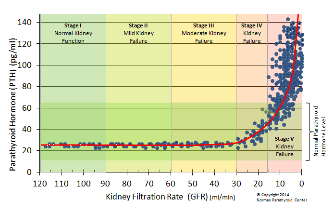Secondary hyperparathyroidism is a disease of the parathyroid glands that was caused by some other disease. The parathyroid glands grew big and went crazy "secondary" to some other problem.
- SECONDARY HYPERPARATHYROIDISM
-
- Secondary
- caused by something else
- hyper-parathyroid-ism
- condition of too much parathyroid gland activity
- hyper = too much
- parathyroid = parathyroid gland
- ism = a disease or condition
Secondary Hyperparathyroidism is rare, except in certain scenarios.
Primary Hyperparathyroidism is common!

IMPORTANT! Most cases of hyperparathyroidism are PRIMARY hyperparathyroidism, which is what most of this huge website is about. You should NOT read this page if your doctor did not mention secondary hyperparathyroidism. You should read this if you have kidney problems, and you must read this if your doctor said you have high parathyroid hormone and secondary hyperparathyroidism because you are developing kidney failure! You will learn that unless you are having kidney dialysis every other day because you don't have any kidneys, then it is almost guaranteed you do not have secondary hyperparathyroidism. This is the only page of this very large website on secondary hyperparathyroidism.
OK, Here we go: Secondary Hyperparathyroidism:
Secondary hyperparathyroidism means the parathyroid glands are overproducing parathyroid hormone in an attempt to help the body increase the amount of calcium in the blood.It is the only job of the parathyroid glands to maintain normal calcium levels and the four parathyroid glands will increase the production of their hormone (parathyroid hormone PTH) if the calcium is too low. When a person has secondary hyperparathyroidism, then something is causing the parathyroid glands to become over active, thus we say it is 'secondary' (caused by) something else. Secondary hyperparathyroidism cannot ever be associated with high blood calcium. Even a slightly high calcium level excludes the possibility of secondary hyperparathyroidism. Thus if your calcium level is 10.0 mg/dl or higher (2.5 mmol/l or higher for our European friends) you cannot have secondary hyperparathyroidism.
Secondary hyperparathyroidism only occurs in a few situations where a patient cannot absorb enough calcium in their diet, or they have kidney failure requiring dialysis and they lose control of calcium and phosphorus. Because it is the primary and only job of the parathyroid glands to help maintain calcium in the normal range, a low calcium level will cause all four parathyroid glands to produce more parathyroid hormone (PTH) in an attempt to increase calcium absorption in the intestines, and to remove calcium out of the bones. The net effect is that the parathyroid glands will increase the amount of calcium in the blood by taking it out of the bones-but this can only happen if the blood calcium is low to start with. Thus the parathyroid glands are overworking 'secondary' to (because of) a low blood calcium level. If you have a high normal, or high calcium level, you cannot develop secondary hyperparathyroidism.
Causes of Secondary Hyperparathyroidism
There are only a few causes of secondary hyperparathyroidism. In addition to kidney failure, there are a few causes of secondary hyperparathyroidism which are associated with poor absorption of calcium by the intestines, leading to low normal or low blood calcium. If you don't have one of these situations, then you cannot have secondary hyperparathyroidism. Remember, the parathyroid glands are unhappy and going crazy because the calcium is low (or phosphorus is high--more about that later).
Causes of Secondary Hyperparathyroidism
-
Kidney failure requiring dialysis (GFR less than 25)
- If you are not on dialysis, or had kidney failure for years, it is almost impossible to have secondary hyperparathyroidism due to kidney problems.
-
Stomach or intestine bypass for obesity surgery
- Gastric Stapling
- Roux-n-Y Bypass
- Gastric (stomach) Bypass Note that it takes at least 10-12 years after the bypass surgery before the parathyroid glands are affected.
- Celiac Disease (typically severe for decades, not a few years)
- Crohn's Disease (typically severe for decades)
-
Severe vitamin D deficiency
- Must have low blood calcium levels Remember a LOW vitamin D CANNOT cause the blood calcium to go HIGH. This is impossible.
- Note: Primary hyperparathyroidism also causes low Vitamin D, so if your Vitamin D is low but your calcium is high, you have a parathyroid tumor due to PRIMARY hyperparathyroidism.
- This is the most common mistake in all of medicine. Low vitamin D cannot cause high blood calcium. If your doctor said you have secondary hyperparathyroidism because your vitamin D is low, then check your calcium. If your calcium is high, then you have primary hyperparathyroidism, not secondary. A terrible, backwards mistake made all the time!
Confusion of Primary vs. Secondary Hyperparathyroidism
The biggest mistake made by all types of doctors, including nephrologists and endocrinologists is to confuse primary hyperparathyroidism with secondary hyperparathyroidism. This is VERY important since primary hyperparathyroidism must be cured with surgery while secondary hyperparathyroidism is treated with vitamin D (and calcium). Think of these two as opposites! If you simply remember that secondary hyperparathyroidism cannot ever be associated with high blood calcium, then you will get this correct almost all the time. If it is so simple, then why do doctors get this wrong so often? We wish we could tell you that answer, but we see this mistake literally every day. This is why your doctors will ask questions about stomach surgery, kidney stones and dialysis. Vitamin D can have great benefits for many people, but must be avoided in people with high blood calcium (primary hyperparathyroidism).
Primary hyperparathyroidism is caused by a tumor of a parathyroid gland. This leads to high blood calcium in almost all cases. Primary hyperparathyroidism is treated with surgery to remove the parathyroid tumor from the neck. Primary hyperparathyroidism CANNOT be treated with vitamin D. In fact, giving vitamin D to a patient with high blood calcium can be dangerous and can cause the blood calcium to rise to very high levels and even cause heart attacks and stroke. Primary hyperparathyroidism is discussed in detail in other articles, but you can remember the difference because primary hyperparathyroidism is 'primarily a parathyroid problem'. There is nothing else that caused the parathyroid glands to become active. The person developed a tumor on a parathyroid gland (in their neck).
Secondary hyperparathyroidism is NOT caused by a parathyroid tumor. Secondary hyperparathyroidism is treated with high doses of vitamin D, often including high doses of calcium (depending on the situation).
Why do Doctors Confuse Primary Hyperparathyroidism as Secondary?
Careful here folks... we are about to confuse you. Primary hyperparathyroidism is almost always associated with low vitamin D. About 92% of our last 30,000 patients being operated on for primary hyperparathyroidism (and having a parathyroid tumor removed from their neck) had low vitamin D (less than 30 ng/ml in the U.S. and less than 80 nmol/L in most other countries) (different units of measure).
It is the low vitamin D that confuses doctors. They often make the assumption that the low vitamin D is the problem, and therefore commonly jump to the conclusion that the patient has secondary hyperparathyroidism. Since low vitamin D is common, and giving vitamin D is a good thing, they just assume the patient has low vitamin D and this has somehow caused a problem with the parathyroid glands that has lead to high blood calcium. This cannot happen. There is no mechanism by which a low vitamin D level can lead to high blood calcium. Vitamin D is required for calcium absorption in the intestines, and therefore, you cannot, under any circumstance have high blood calcium because of the low vitamin D. If your calcium is high (even slightly high) and your vitamin D is low, then the excess calcium in the blood must have come from somewhere other than the intestines and your diet. The only other source of calcium is your bones and that is the primary action of parathyroid hormone.
Thus, if the calcium is high and the vitamin D is low, the patient is almost guaranteed to have primary hyperparathyroidism and a parathyroid tumor in their neck. The body is converting Vitamin D-25 to Vitamin D 1-25 at a very high rate so the "25" form goes down... but us doctors measure the 25-D and we don't measure the 1-25-D. Almost all patients with a parathyroid tumor have low vitamin D-25, and high 1-25 (but doctors don't routinely measure the 1-25 form). It is inappropriate to give vitamin D to a patient with high blood calcium. This can be a bit confusing... but remember, when the calcium goes up, the vitamin D-25 goes down in nearly all cases. But, a low vitamin d-25 CANNOT cause the calcuim to go up.
Let's get back to calcuim levels. Remember, you cannot have secondary hyperparathyroidism and have high blood calcium. Secondary hyperparathyroidism can ONLY be seen with calcium levels that are mid-normal, low normal, or low.
Kidney Disease and Increasing Parathyroid Hormone Levels
 Secondary hyperparathyroidism occurs in all (yes, all) patients who have kidney failure, however it typicaly takes years of kidney failure. In fact, usually a patient will have such severe kidney failure that they are on dialysis before they have significant secondary hyperparathyroidism. This is another amazingly common mistake made by many nephrologists. Unfortunately, we see cases literally every day where doctors confuse primary and secondary hyperparathyroidism. This graph shows kidney function on the bottom "X" axis with the green areas being great kidney function where the kidney can filter over 90 ml of blood every minute (called GFR, meaning glomerular filtration rate). As the kidneys fail, they filter (clean) less of the blood, so that a kidney that can only filter between 30 and 60 ml per minute (about a coffee cup full) are said to have Stage III kidney failure. The vertical "Y" axis shows parathyroid hormone levels. This graph shows that parathyroid hormone (PTH) levels (a measure of the activity of the parathyroid glands) remains normal (between 15 and 65 pg/ml) until patients have a GFR less than 15. The blue dots are PTH levels in 300 patients with worsening kidney failure showing that the PTH does not rise until the GFR is less than 20, or really, less than 15. And, it needs to be less than 15 for about 6-12 months before the PTH levels start to rise. You cannot have Stage II, or Stage III kidney failure and have secondary hyperparathyroidism. This does not happen. In fact, it is uncommon to have Stage IV kidney failure and have secondary hyperparathyroidism. In the vast majority of cases you cannot have secondary hyperparathyroidism unless you have Stage 4 or stage 5 kidney failure (stage 5 is typically on dialysis). Taken within the context of this website... doctors (and patients) trying to figure out if a person has primary hyperparathyroidism), if the patient is not on dialysis, or near dialysis, and the patient has high PTH levels associated with high normal or high calcium, then they almost surely do not have secondary hyperparathyroidism. This mistake is made very commonly. Remember, a patient cannot have secondary hyperparathyroidism if their calcium is not low normal or low.
Secondary hyperparathyroidism occurs in all (yes, all) patients who have kidney failure, however it typicaly takes years of kidney failure. In fact, usually a patient will have such severe kidney failure that they are on dialysis before they have significant secondary hyperparathyroidism. This is another amazingly common mistake made by many nephrologists. Unfortunately, we see cases literally every day where doctors confuse primary and secondary hyperparathyroidism. This graph shows kidney function on the bottom "X" axis with the green areas being great kidney function where the kidney can filter over 90 ml of blood every minute (called GFR, meaning glomerular filtration rate). As the kidneys fail, they filter (clean) less of the blood, so that a kidney that can only filter between 30 and 60 ml per minute (about a coffee cup full) are said to have Stage III kidney failure. The vertical "Y" axis shows parathyroid hormone levels. This graph shows that parathyroid hormone (PTH) levels (a measure of the activity of the parathyroid glands) remains normal (between 15 and 65 pg/ml) until patients have a GFR less than 15. The blue dots are PTH levels in 300 patients with worsening kidney failure showing that the PTH does not rise until the GFR is less than 20, or really, less than 15. And, it needs to be less than 15 for about 6-12 months before the PTH levels start to rise. You cannot have Stage II, or Stage III kidney failure and have secondary hyperparathyroidism. This does not happen. In fact, it is uncommon to have Stage IV kidney failure and have secondary hyperparathyroidism. In the vast majority of cases you cannot have secondary hyperparathyroidism unless you have Stage 4 or stage 5 kidney failure (stage 5 is typically on dialysis). Taken within the context of this website... doctors (and patients) trying to figure out if a person has primary hyperparathyroidism), if the patient is not on dialysis, or near dialysis, and the patient has high PTH levels associated with high normal or high calcium, then they almost surely do not have secondary hyperparathyroidism. This mistake is made very commonly. Remember, a patient cannot have secondary hyperparathyroidism if their calcium is not low normal or low.
Therefore, if you have 1) kidney failure of some form, 2) your parathyroid hormone (PTH) is high, and 3) your calcium is 10.0 mg/dl or higher, then you almost certainly have PRIMARY hyperparathyroidism and you do not have secondary hyperparathyroidism. Why is this important? Because it is possible that the parathyroid tumor is contributing to the kidney damage. We see this mistake made every single day. If your PTH is high and your doctors say you have secondary hyperparathyroidism and you are not on dialysis, or not had kidney failure for years, then you almost for sure have PRIMARY hyperparathyroidism and you need to get your parathyroid TUMOR out of your neck because it is likely causing further damage to your kidneys. PLEASE read this again. Parathyroid tumors kill kidneys (over a number of years), and if you have high PTH levels and you are not on dialysis, then it is very likely the parathyroid tumor is either directly responsible for the kidney failure, or it is making it worse. You cannot have secondary hyperparathyroidism unless your calcium is very low, and you cannot have "clinically significant" secondary hyperparathyroidism if your GFR is over 25.
Why did the secondary hyperparathyroidism occur?
The common thread for all of these conditions is that the intestines do not absorb enough calcium because there is either 1) a problem with the intestine wall so that the calcium cannot get from inside the intestines through the intestine wall and into the blood, or 2) not enough vitamin D to help transport the calcium through the intestine wall. Remember, the only thing vitamin D does in the human body (with a few exceptions) is to transport calcium from our food into our blood through the intestine wall. Vitamin D is a transport molecule for calcium. Thus if a person has a very low vitamin D level, they will have problems absorbing calcium that they eat into their blood. This is why most milk has vitamin D added to it, and why almost all calcium pills you can buy have vitamin D in them. To understand why kidney failure causes secondary hyperparathyroidism you have to remember that the active form of vitamin D is produced by the kidney! Thus if the kidneys have failed, the patient cannot activate the vitamin D and therefore they cannot absorb calcium in their diet.
Remember, to have secondary hyperparathyroidism, you MUST have a low blood calcium--which is what caused the parathyroid glands to go crazy. If your doctor says that you have high blood calcium because you have a low vitamin D level, he/she is wrong. It is impossible for low vitamin D to cause a high blood calcium. Vitamin D is required to absorb calcium from our diets through our intestine wall, and if the vitamin D is low then you can't absorb enough calcium and your blood calcium goes LOW. HOWEVER, this is RARE, and can ONLY occur in the diseases above. And, you are VERY SICK from these other diseases, so it isn't a surprise.
Secondary Hyperparathyroidism: How Many Parathyroid Glands are Bad?
Since secondary hyperparathyroidism is caused by some external force acting on the parathyroid glands (almost always this is low blood calcium), then all four of the parathyroid glands are exposed to this same LOW blood calcium level and thus all four glands go crazy and get big and juicy. When we operate on people with secondary hyperparathyroidism we find FOUR bad glands, and zero good glands, because they all were exposed to the bad situation of low calcium so they are trying very hard to get the blood calcium higher (remember, that's what parathyroid glands do--they control the blood calcium).
Patients with primary hyperparathyroidism have the disease because they grew a tumor on one (or two) of their parathyroid glands. Patients with primary hyperparathyroidism almost never have 4 bad glands (see photos of parathyroid tumors we took out of people--it isn't gross!).
What to read next
- Watch or video of a parathyroid tumor removal by Dr Norman in less than 13 minutes (total time). Remember, you really want your surgeon to look at all four of your parathyroid glands. Watch this video to see why this is important.
- Read our "testimonial" page to see the stories of about 2,000 parathyroid patients.
- Read our blog about hyperparathyroidism being more deadly than high cholesterol
- See more pictures of parathyroid tumors removed from people's necks.
- See our Map of where our patients come from; some are probably your neighbors!
- How to become our patient




